
A couple of years ago, collaborative research courtesy of experts at Harvard, MIT, and Swiss labs revealed something extraordinary. They found that the concrete used by Romans had self-healing properties, giving it an uncharacteristically high resilience, which allowed some of those ancient structures to survive roughly two thousand years without crumbling to dust. Partnering with experts at Google, a team of scientists and researchers are now trying to crack the code for self-healing asphalt material that could rid us of the bane of potholes in the modern age.
Advertisement
Potholes are a pricey problem. The U.K. alone spends over a hundred million pounds each year to fix them. Then we have the problems potholes pose to automobiles. Potholes raise problems such as tire damage, wheel alignment woes, suspension troubles, and risks to vehicle exhaust systems, aside from road safety hazards and accident risks. What if we make roads that heal on their own, thereby preventing cracks from turning into potholes?
With some help from AI, experts at the King’s College London and Swansea University have created a new kind of asphalt material that can “repair its own cracks over time, eliminating the need for manual maintenance.” Inspired by living plant and animal tissues that heal injuries on their own, the team. Asphalt cracks because the binder material, called bitumen, ages over time and becomes brittle. Owing to natural factors such as temperature fluctuations, it develops cracks, while water seepage only worsens it over time.
Advertisement
How Google AI is solving the problem
The team at Google is relying on the same fundamental technique that has allowed AI to make breakthroughs in drug development. In this case, the experts created virtual molecules using Google’s AI stack, with the goal of studying their chemical interaction with the bitumen component of asphalt. The team claims to have discovered a method for reversing the crack formation and allowing the asphalt to stitch itself. At the heart of this breakthrough are tiny spores.
Advertisement
These spores, made using plant parts and filled with recycled oil, are thinner than human hair. When asphalt starts to crack, the oils are released and fill the cracks. As per research, the special hybrid material created by the team can heal microcracks in roughly 50 minutes. The research, published in the Applied Materials & Interfaces, also marks the first time that bio-based spores made with recycled oils have demonstrated self-healing activity in pavements. The oil mixture, in this case, was derived from sunflower and mixed with sporopollenin, a resilient, naturally occurring polymer that forms the tough exterior of plant spores and pollen grains.
On the technical side of things, the researchers developed a data-driven framework that can generate models of complex organic fluids. This approach not only reduces human bias but also accelerates the whole process of creating accurate representative models and molecular designs of complex fluids. It becomes easier to understand the behavior and properties of fluids, speeding up the development of new products.
Advertisement
How do spores trigger self-healing in asphalt?
Think of these spores as materials that grant adhesive superpowers to the asphalt material used to make roads and pavements, allowing the cracks to heal in time. As per research published in the Materials and Structures journal, what we are dealing with here is a process called thermo-oxidative aging, which triggers the formation of cracks.
Advertisement
Due to the combined effect of high temperature and oxygen exposure, the lighter chemical components of bitumen vaporize. As a result, the heavier components, such as resins and asphaltenes, form clusters, which reduces the fluidity of bitumen. This is how bitumen becomes brittle and eventually, cracks start to appear.
This is where spores or “alginate” come into the picture. Filled with low-viscosity oils, these tiny capsules return the elasticity and viscosity back to the bitumen material while managing to retain their shape when mixed with the asphalt material. Over time, when cracks start to appear, or due to the mechanical stress of heavy vehicles moving on the surface, the walls of these capsules rupture, releasing the biobased materials.
Advertisement
The oil diffuses within the cracks and slowly softens the bitumen, allowing it to flow like a dense liquid and slowly seal the cracks on its own. Similar results were obtained in other research funded by the Chilean government’s National Research and Development Agency (ANID), highlighting the self-healing benefits of these “encapsulated rejuvenators.” Additional research is also underway to develop self-healing concrete using sustainable materials. It’s a better approach, after all, than using AI to detect potholes.



